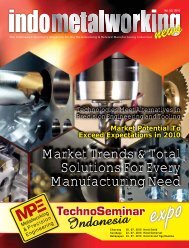High Speed Machining Precision Tooling - Indobiz.biz
High Speed Machining Precision Tooling - Indobiz.biz
High Speed Machining Precision Tooling - Indobiz.biz
Create successful ePaper yourself
Turn your PDF publications into a flip-book with our unique Google optimized e-Paper software.
for multiple jobs; so, depending on<br />
volume, it may be able to handle the<br />
tasks of several fi xed-automation<br />
systems.<br />
A certain volume of parts will justify<br />
the investment of automation for each<br />
company, and an accurate assessment<br />
of goals and workfl ow help determine<br />
what that volume is. If you make only<br />
small runs of parts, automation becomes<br />
more challenging. If, however, you can<br />
identify two or three components that<br />
can be automated, a robot that can be<br />
programmed to recognize those parts<br />
can offer greater fl exibility and may<br />
benefi t even small fabricators who may<br />
not have signifi cant volume of a single<br />
part.<br />
Although a robot is more expensive<br />
than a fi xed-automation system, you<br />
should be sure to consider the cost of<br />
the necessary tooling before deciding<br />
between the two. Fixed automation<br />
systems can become quite expensive<br />
if extensive changes are required to<br />
retool a part to ensure it can be welded<br />
consistently.<br />
READY TO AUTOMATE?<br />
A streamlined workfl ow is one of<br />
automation’s benefi ts. But a smooth<br />
workfl ow requires you to look beyond<br />
the weld cell to ensure your facility<br />
can accommodate a smooth fl ow of<br />
materials. For example, investing in<br />
an automated system to increase<br />
productivity that is placed in a corner<br />
where each part must be handled twice<br />
makes little sense.<br />
You should have a dependable supply of<br />
parts to avoid moving a bottleneck from<br />
one area to another. Also remember<br />
to consider the expected cycle time of<br />
the robot. Can your personnel supply<br />
enough parts to keep up with the<br />
demand of the automated system’s<br />
cycle time? If not, the supply of parts,<br />
including where they are stored and<br />
how they are moved, must be adjusted<br />
for the automation to be successful.<br />
Otherwise, a robot will sit idle waiting for<br />
components to come down the line - a<br />
costly and counterproductive state for<br />
any automated welding system.<br />
You must have the right power and gas<br />
systems in place, or factor in the cost<br />
of implementing these systems. To<br />
move to an automated system, a facility<br />
needs a 480-volt, three-phase power<br />
supply, as well as bulk delivery of gas<br />
and wire. A gas manifold system may<br />
add to the initial cost of automation, but<br />
will minimize downtime for changing gas<br />
cylinders in the long run.<br />
Determining who will oversee the<br />
automated system and providing training<br />
is essential. Most robot OEMs offer a<br />
weeklong training course explaining<br />
how to operate the equipment. This<br />
course, followed by a week of advanced<br />
programming, is recommended.<br />
Because there is more to welding<br />
automation than simply purchasing<br />
a robot, partnering with a competent<br />
integrator or automation specialist can<br />
help ensure success. Your automation<br />
specialist should:<br />
• Help determine if parts are suitable<br />
for automation, and, if not, what<br />
is required to make them suitable.<br />
• Analyze the workfl ow and facility to<br />
identify potential roadblocks.<br />
• Analyze the true costs involved,<br />
including facility updates and<br />
tooling.<br />
• Determine the potential payback<br />
of the automation investment.<br />
• Help identify goals and develop<br />
a precise plan and time table to<br />
achieve those goals.<br />
• Explain automation options and<br />
help select those that best fi t your<br />
needs.<br />
• Help select a welding power<br />
source that has the fl exibility to<br />
maximize travel speed, minimize<br />
spatter, eliminate over-welding,<br />
provide great arc starting<br />
characteristics and increase<br />
fi rst-pass weld quality.<br />
Remember, no single path to successful<br />
welding automation exists, but a wellthought-out<br />
plan that includes accurate<br />
evaluations is a good start to the<br />
journey.<br />
30<br />
indometalworking news Vol. 2 / 2008




